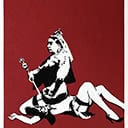Truth from the King Country: Load Bearing Structures: Series Three
22.8 x 30.5 cm
est. $55,000 - 70,000
PROVENANCE
Private Collection, Auckland
Truth From the King Country is one of the most numerous of McCahon's series, comprising at least 35 individual paintings in five sub-series painted in 1978-79. It was his last extensive series, and also the last in which extensive landscape imagery is seen. Uniquely for McCahon these works were painted on commercial canvasboards, a humble support much used by amateur artists and readily available from art supply shops. The canvasboards came in differing sizes, all quite modest in scale but varying from 233 x 235mm for the smallest to 253 x 335mm for the largest, each sub-series being differentiated by the size of the boards. The third series, to which this work belongs, consisted of six paintings. Truth from the King Country was never exhibited as a whole. Initially McCahon intended to give them away to friends and many were disposed of in this fashion, though eventually some were made available for sale through his Wellington dealer, Peter McLeavey. Each work in the series consists of variations of the same two elements - a dark T-shape in the foreground against a richly coloured background of sky and/or hills. The main title, Truth from the King Country gives priority to the landscape setting, identified with the King Country, the remote and hilly region of the central North Island, so named because of its association with the Maori King movement during the New Zealand wars of the nineteenth century. The sub-title Load Bearing Structures relates to the foreground T-shape, which may be read either, first, as a bridge or viaduct, a man-made structure common in the region as a means of spanning deep valleys for road or rail, or, second, as a cross, the T-shaped or Tau cross generally favoured (though not exclusively) by McCahon, especially in his later work. The works may therefore be read both as realism (bridges or viaducts against skies and hills viewed at sunrise or sunset - hence the vivid colour), and as symbolism (as explorations of faith or belief). In this particular example the structure is placed centrally with the horizontal arm stretching from edge to edge. The range of lowish or distant dark hills also extends from edge to edge leaving extensive space for the glowing sky extending both below and above the arms of the cross. The work is exquisitely painted, as particularly evident in the subtle variations of colour in the sky and the refined delicacy of the long horizon, now clear, now obscured by cloud.





